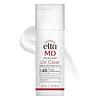What's inside
What's inside
 Key Ingredients
Key Ingredients

 Benefits
Benefits

 Concerns
Concerns

 Ingredients Side-by-side
Ingredients Side-by-side

Zinc Oxide 9%
Cosmetic ColorantEthylhexyl Methoxycinnamate 7.5%
UV AbsorberWater
Skin ConditioningCyclopentasiloxane
EmollientNiacinamide
SmoothingOctyldodecyl Neopentanoate
EmollientHydroxyethyl Acrylate/Sodium Acryloyldimethyl Taurate Copolymer
Emulsion StabilisingButylene Glycol
HumectantPhenoxyethanol
PreservativePolyisobutene
Triethoxycaprylylsilane
Tocopheryl Acetate
AntioxidantPEG-7 Trimethylolpropane Coconut Ether
EmulsifyingOleth-3 Phosphate
Iodopropynyl Butylcarbamate
PreservativeLactic Acid
BufferingSodium Hyaluronate
HumectantPhosphoric Acid
BufferingZinc Oxide 9%, Ethylhexyl Methoxycinnamate 7.5%, Water, Cyclopentasiloxane, Niacinamide, Octyldodecyl Neopentanoate, Hydroxyethyl Acrylate/Sodium Acryloyldimethyl Taurate Copolymer, Butylene Glycol, Phenoxyethanol, Polyisobutene, Triethoxycaprylylsilane, Tocopheryl Acetate, PEG-7 Trimethylolpropane Coconut Ether, Oleth-3 Phosphate, Iodopropynyl Butylcarbamate, Lactic Acid, Sodium Hyaluronate, Phosphoric Acid
Octyldodecanol
EmollientC12-15 Alkyl Benzoate
AntimicrobialSilica
AbrasiveBis-Ethylhexyloxyphenol Methoxyphenyl Triazine
Skin ConditioningEthylhexyl Methoxycinnamate
UV AbsorberEthylhexyl Triazone
UV AbsorberEuphorbia Cerifera Cera
AstringentHomosalate
Skin ConditioningOctocrylene
UV AbsorberOzokerite
Emulsion StabilisingButyl Methoxydibenzoylmethane
UV AbsorberCopernicia Cerifera Cera
EmollientTitanium Dioxide
Cosmetic ColorantDipropylene Glycol Dibenzoate
EmollientHydrogenated Coco-Glycerides
EmollientCera Microcristallina
Emulsion StabilisingPolysilicone-15
UV FilterRhus Verniciflua Peel Cera
EmollientWater
Skin ConditioningBis-Ethylhexyl Hydroxydimethoxy Benzylmalonate
AntioxidantRosa Canina Fruit Oil
EmollientHelianthus Annuus Seed Oil
EmollientPPG-15 Stearyl Ether Benzoate
EmollientDimethicone
EmollientZingiber Officinale Root Extract
MaskingLupinus Albus Seed Extract
Skin ConditioningEthylhexylglycerin
Skin ConditioningVp/Hexadecene Copolymer
Hydrolyzed Wheat Protein/Pvp Crosspolymer
Tocopheryl Acetate
AntioxidantDisodium EDTA
Phenoxyethanol
PreservativePotassium Sorbate
PreservativeOctyldodecanol, C12-15 Alkyl Benzoate, Silica, Bis-Ethylhexyloxyphenol Methoxyphenyl Triazine, Ethylhexyl Methoxycinnamate, Ethylhexyl Triazone, Euphorbia Cerifera Cera, Homosalate, Octocrylene, Ozokerite, Butyl Methoxydibenzoylmethane, Copernicia Cerifera Cera, Titanium Dioxide, Dipropylene Glycol Dibenzoate, Hydrogenated Coco-Glycerides, Cera Microcristallina, Polysilicone-15, Rhus Verniciflua Peel Cera, Water, Bis-Ethylhexyl Hydroxydimethoxy Benzylmalonate, Rosa Canina Fruit Oil, Helianthus Annuus Seed Oil, PPG-15 Stearyl Ether Benzoate, Dimethicone, Zingiber Officinale Root Extract, Lupinus Albus Seed Extract, Ethylhexylglycerin, Vp/Hexadecene Copolymer, Hydrolyzed Wheat Protein/Pvp Crosspolymer, Tocopheryl Acetate, Disodium EDTA, Phenoxyethanol, Potassium Sorbate
 Reviews
Reviews

Ingredients Explained
These ingredients are found in both products.
Ingredients higher up in an ingredient list are typically present in a larger amount.
Ethylhexyl Methoxycinnamate is an organic compound that provides UVB protection. It often goes by the more common name of octinoxate. It is created from methoxycinnamic acid and 2-ethylhexanol.
Ethylhexyl Methoxycinnamate absorbs UVB rays with wavelengths between 280-320 nm. UV absorbers protect your skin by using chemical reactions to convert UV rays into heat and energy.
UVB (290-320 nm) rays emit more energy than UVA rays. They are capable of damaging DNA, causing sunburns and are thought to be linked to skin cancer.
The state of Hawaii has banned sunscreens containing octinoxate due to its potential impact on coral reefs. More research is needed to bridge gaps in this research. The European Union allows higher levels of octinoxate in sunscreens than the US and Australia.
Ethylhexyl Methoxycinnamate is oil soluble. It is not stable and may lose efficacy when exposed to sunlight.
Learn more about Ethylhexyl MethoxycinnamatePhenoxyethanol is a preservative that has germicide, antimicrobial, and aromatic properties. Studies show that phenoxyethanol can prevent microbial growth. By itself, it has a scent that is similar to that of a rose.
It's often used in formulations along with Caprylyl Glycol to preserve the shelf life of products.
Tocopheryl Acetate is AKA Vitamin E. It is an antioxidant and protects your skin from free radicals. Free radicals damage the skin by breaking down collagen.
One study found using Tocopheryl Acetate with Vitamin C decreased the number of sunburned cells.
Tocopheryl Acetate is commonly found in both skincare and dietary supplements.
Learn more about Tocopheryl AcetateWater. It's the most common cosmetic ingredient of all. You'll usually see it at the top of ingredient lists, meaning that it makes up the largest part of the product.
So why is it so popular? Water most often acts as a solvent - this means that it helps dissolve other ingredients into the formulation.
You'll also recognize water as that liquid we all need to stay alive. If you see this, drink a glass of water. Stay hydrated!
Learn more about Water